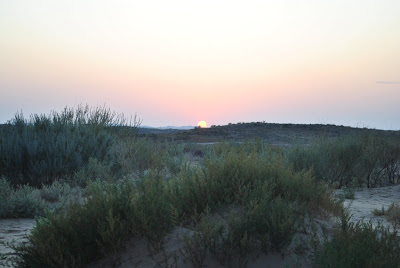









The Gobi Desert

The Earth is not a Cold Dead Place
-Explosions in the Sky








On our way we saw the mountains from our bus window, and I snapped a quick picture while at a rest stop.
Once in the grasslands, we had the opportunity to ride horses if we liked, but we declined in favor of walking around. (I asked the woman in charge if we could ride fast. Her immediate response was, “No.”)
The people in the area obviously raise cattle, so as we meandered we passed cows and horses kept within loose wire fences.
The grasslands were beautiful, if in a rather brittle way. The wide open blue sky - a feature of all of Inner Mongolia, so far as we could tell – was absolutely dazzling though. I already miss it.
Happy National Holiday, everyone! This past week two friends and I went to Inner Mongolia for our October break. Inner Mongolia is a province of China, just south of the independent country of Mongolia.
An arid province, Inner Mongolia is usually known for its horse-riding, yurt-living nomadic peoples roaming the beautiful grasslands. We were lucky enough to see horses, yurts, the grasslands, and much more.
Inner Mongolia has had Han immigration for centuries, so the population is actually about 80% Han Chinese, and about 20% ethnic Mongolian. Since most of the population is Han Chinese, we didn’t have any trouble getting around with our Mandarin. Many people also spoke to each other in Mongolian though, and Mongolian script was everyone. It’s really beautiful, as you can see below:
(In Mongolia, because of Russian influence, they use Cyrillic to write Mongolian.)

Under Genghis Khan and then his grandson Kublai Khan, the Mongolian empire (Yuan dynasty) was established. Though we tend to remember Genghis Khan for his cruel wartime tactics, Mongolians tend to remember him as a unifier. Pictures of a benevolent-looking Genghis Khan are everywhere:

Mongolia has also been heavily influenced by Tibetan Buddhism, which we could see in the Buddhist temples and Tibetan prayer flags everywhere.
And, in case you're curious, Mongolian food is heavy on potatoes, mutton, and dairy products, all of which we ate in abundance. It’s cold there!, and high-calorie food was just the ticket.
On our trip, we saw the grasslands:



 There were also displays of many other types of plants besides orchids. I thought the cacti were quite attractive.
There were also displays of many other types of plants besides orchids. I thought the cacti were quite attractive.


 (A Tuk-Tuk, ubiquitous three wheeled golf cart masquerading as a taxi. They're fun, if you're ok with the potential for adventure.)
(A Tuk-Tuk, ubiquitous three wheeled golf cart masquerading as a taxi. They're fun, if you're ok with the potential for adventure.)



